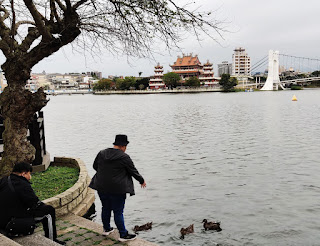subtitle
-- Working draft for upcoming book by Mark Caltonhill, author of "Private Prayers and Public Parades - Exploring the religious life of Taipei" and other works.
Sunday, 6 March 2022
Longtan (龍潭) District, Taoyuan City
This area is inhabited predominanty by Hakka people, whose pronunciation of 龍潭 (literally "Dragon Lake"; Mdn. Long-tan) as Liung-tam is possibly of relevance to the origins of the district's (formerly township) name.
Popular legend maintains that, after a period of prolonged drought, one (or more) early inhabitants in the middle of the 18th century prayed on the bank of the lake for rain, was rewarded, and so named it 靈潭陂 (Mdn. Ling-tan-pi; "Spirit Lake Bank" -- Abe Akiyoshi uses the similar-meaning 靈潭坡, Mdn Ling-tan-po, presumably because 陂 is at best obscure in Japanese).
Another explanation is that the lake, which still provides the focal point of the township, was originally covered with a layer of wild-growing 菱 (water caltrop / chestnut Trapa natans), from which it was called 菱潭陂 ("Water-Caltrop Lake Bank").
In Hakka, both 靈 and 菱 are pronounced something like lin. One suggestion of how 靈潭陂 or 菱潭陂 became 龍潭陂 was simply the phonetic similarity of lin and liung in Hakka (which would have been a less likely shift in Mandarin from ling to long), [MC: perhaps because water caltrop no longer grew there or the earlier "spirit lake shrine" had been demolished].
Alternatively, the earlier legend has a coda in which, during a wet and windy night, someone observed yellow dragons within 靈潭陂, thus leading to its new name of 龍潭陂 and the town as 龍潭莊 (Longtan Township) in the Japanese colonial period.
Text and photo copyright Jiyue Publications 2022
Subscribe to:
Posts (Atom)

